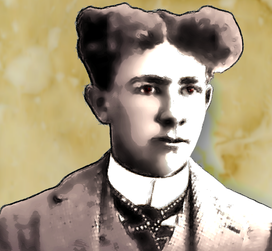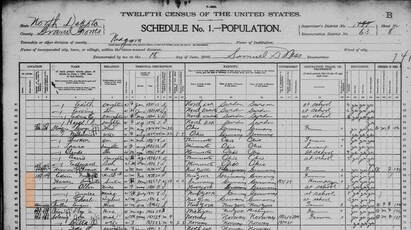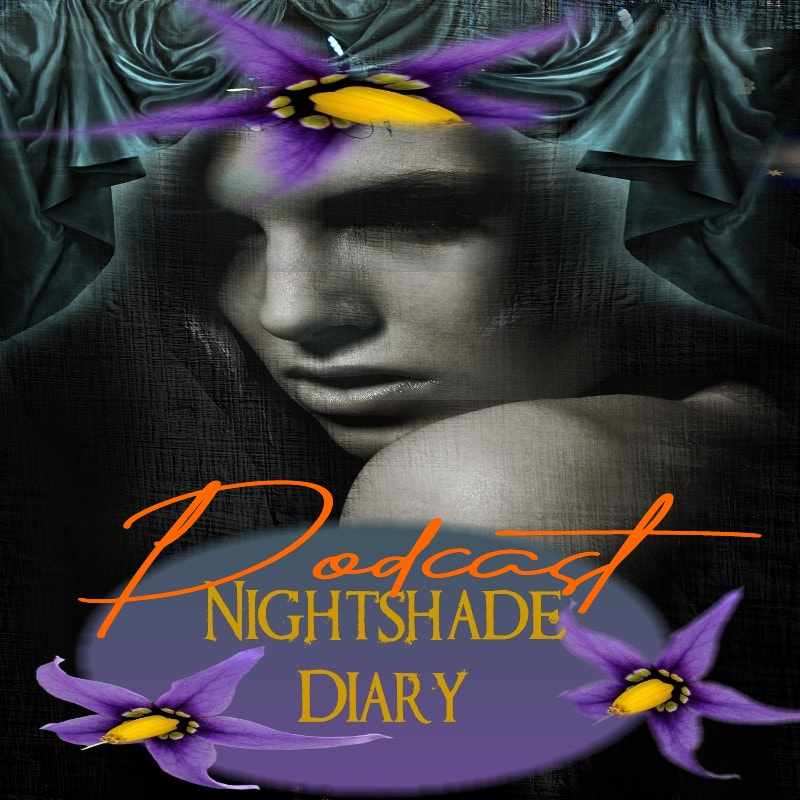 By M.P. Pellicer | Stranger Than Fiction Stories Beware the insane, because they might have lost their mind, but not the capacity to deceive.  Several buildings on the State Insane Hospital campus in Jamestown, North Dakota, circa 1895-1901 Several buildings on the State Insane Hospital campus in Jamestown, North Dakota, circa 1895-1901 Grand Forks, North Dakota February, 1904 Eugene Butler came to North Dakota in 1880 from Middleport, New York where his brother still lived, however they did not get along. A sister who was adjudged insane had died several years before. He lived by himself on a farm at Shawnee, and was quite wealthy by the measure of the day. His 400-acre property was estimated to be worth close to $40,000. This would be the equivalent of over $1 million present day. He also held the mortgage on an adjoining piece of land. Eugene might have been eccentric, but he wasn't stupid, however years would pass before the townspeople would understand just how duplicitous he truly was. It all started in a nonsensical way. Eugene Butler was 56 years old, when he started to brood over hallucinations that all the old maids and widows had set their caps on him, and wanted to bring him to the altar since it was a leap year. He also claimed that men would come to his home during the night, and force him to get up, dress and take long walks and horseback rides, which he did by screaming at the top of his voice. Neighbors said he was seen riding his horse at night at break neck speed. Before this he was known by his neighbors as being a recluse and a miser, however due to his behavior deteriorating he was committed to the insane hospital at Jamestown.  Typical North Dakota farmhouse Typical North Dakota farmhouse His house was sparsely furnished, and he was known to carry all his effect in his pockets. The custodian of the court found he had $3,000 including cash, certificates of deposit, checks and wheat receipts. Eugene was crazy but not poor. Six months later, alienists at the asylum were of the opinion that there was little chance of recovery for Eugene Butler. He was described as a man of short stature, who was gallant and attended the hospital dances. He fell desperately in love with one of the lady physicians. During his time there he had only occasional bouts of believing that "they were after him". He complained that his enemies had followed him to the asylum. His doctor found that he had a mortal fear of Kodak cameras, believing they could end his life if his photograph was taken. However outside of this he was never violent. He died on October 26, 1911 from phlebitis at the age of 62. There was nothing unusual in this event, and his body was shipped to Saint Stephen's Cemetery in Middleport, New York for burial. The only notoriety attached to Eugene Butler at the time of death was a squabble among his relatives, who each wanted a piece of his estate. It was noted that an unnamed sister had died in an insane asylum years before, and his brother Oscar Butler had died at the state hospital in Buffalo three months before Eugene did. The inference was unmistakable, which was that Eugene's family had a deep streak of insanity running through it.  Grand Forks, ND courthouse c.1915 Grand Forks, ND courthouse c.1915 Eugene Butler was forgotten, if not by his family, by the world at large. This all changed in July, 1915 when Leo Verhulehn was digging a cellar under what had once been Eugene's house. He found six skeletons with crushed skulls buried underneath the foundation. Their heads had been split open by an axe. All were thought to be adult men, with the exception of one which seemed to be a young boy or girl. They were dropped through an opening in the floor. The only thing left were the bones; every possible clue to their identity had been destroyed. Authorities believed these were persons that Butler had employed as farmhands during the summer, or the remains of two housekeepers once employed by Butler, and their children. It was suspected the victims were transients, which why they were not missed. The commentary among the townspeople was that Butler was really insane for many years before his commitment.  The bones of the victims were held at the sheriff's office but the their murder was never solved (Source - Bowbell's Tribune, c.Sept. 1915) The bones of the victims were held at the sheriff's office but the their murder was never solved (Source - Bowbell's Tribune, c.Sept. 1915) Once the bones were examined it was found five of them had been killed at the same time. They were a man, a woman and three children. At a later date one man was killed. The bodies of the family were buried in a single hole, and the other victim in a spot about ten feet away from them. Butler had broken the legs of two of the victims in order to get them under the foundation of the house. The dirt around the skeletons was carefully examined for a trace of buttons, shoes or any type of belonging but nothing was found, indicating he buried them naked. The skull of the lone man, which was the most recent indicated he had a crooked nose. It also appeared he used the same sharp instrument in killing the family. Each had a hole in the left side of the skull. None of the neighbors could recall any family disappearing in the area, and during the years he occupied the farm, he lived there by himself. He spoke little about his family history and had no intimate friends. The investigation never made mention of who had lived at the farmhouse before Butler. The structure was only 20 years old. Within a short time of the discovery the state attorney's office received the following letter: I have been requested to make inquiry concerning one John Urbanski, who disappeared near Niagara, ND in 1902. The last heard from him was a letter received by his brother stating that he was working for a bachelor near Niagara ND. The postmark showed that the letter had been mailed at Larimore. John Urbanski was a young man about five feet, seven inches in height, weight 145 pounds, light hair (almost white) and light complexion.  Niagara, North Dakota 1900 census Niagara, North Dakota 1900 census It was noted that the bones were put in a small box and were being kept at the office of Sheriff Art Turner at Grand Forks. Unfortunately many of those who had come to the farmhouse upon discovery of the remains, had stolen some of the bones as souvenirs. Without any material clues, or information from the farmers in the area, the investigation as to the identity of the victims ended. Most probably they were interred in a pauper's grave in the Niagara Cemetery, which served the local community. However the identity of those who were murdered by Eugene Butler some time between 1900 and 1904, could be the individuals listed on the 1900 census shown as living with him. Who knows if the visit of the census taker was what spurred Butler to do away with them, since he wanted no record they had ever lived on his farm. They were Frank Edwin, 22; his sister Augusta Hawke, 37; Olive Hawke, 11; Junice Hawke, 8; and Charles Hawke, 6. Frank was listed as head of the household as was Eugene Butler, Augusta was the housekeeper. All of them listed New York as their birthplace except Augusta, who had come to the United States from Germany in 1880. All of these persons dropped from sight in later censuses or death records. They all correspond to the description of the bones found underneath the house. Did Eugene Butler hire them, and then kill them soon after, before they were seen by the neighbors in the area? As to John Urbanski he too, was never heard from again. Was he the unnamed worker hired by a bachelor farmer in Niagara, North Dakota, and buried ignominiously under a farmhouse? Butler might have been a deeply disturbed man, but he understood the need to deceive and hide his crimes. Beware the insane.
0 Comments
Your comment will be posted after it is approved.
Leave a Reply. |
Stranger Than Fiction StoriesM.P. PellicerAuthor, Narrator and Producer Archives
July 2024
Categories
All
|
Stories of the Supernatural
- Stories of the Supernatural
- Miami Ghost Chronicles
- M.P. Pellicer | Author
- Stranger Than Fiction Stories
- Eerie News
- Supernatural Storytime
-
Astrology Today
- Tarot
- Horoscope
- Zodiac
-
Haunted Places
- Animal Hauntings
- Belleview Biltmore Hotel
- Bobby Mackey's Honky Tonk
- Brookdale Lodge
- Chacachacare Island
- Coral Castle
- Drayton Hall Plantation
- Jonathan Dickinson State Park
- Kreischer Mansion
- Miami Biltmore Hotel
- Miami Forgotten Properties
- Myrtles Plantation
- Pinewood Cemetery
- Rolling Hills Asylum
- St. Ann's Retreat
- Stranahan Cromartie House
- The Devil Tree
- Trans-Allegheny Lunatic Asylum
- West Virginia Penitentiary
- Paranormal Podcasts
"When misguided public opinion honors what is despicable and despises what is honorable, punishes virtue and rewards vice, encourages what is harmful and discourages what is useful, applauds falsehood and smothers truth under indifference or insult, a nation turns its back on progress and can be restored only by the terrible lessons of catastrophe."
- Frederic Bastiat
- Frederic Bastiat

Copyright © 2009-2024 Eleventh Hour LLC. All Rights Reserved ®
DISCLAIMER
DISCLAIMER
 RSS Feed
RSS Feed
















